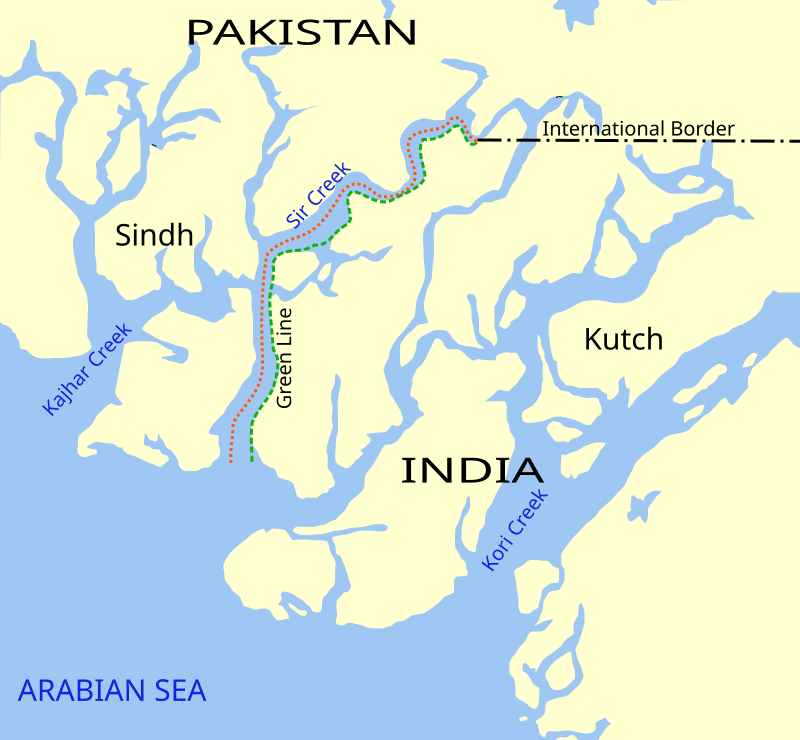In the marshy emptiness of the Rann of Kutch, where land and sea blur into one another, lies a narrow water channel called Sir Creek — a seemingly insignificant strip of tidal water that holds significant strategic and geopolitical weight. For decades, this 120-kilometre-long estuary between India’s Gujarat and Pakistan’s Sindh province has remained one of South Asia’s quietest border disputes. But any attempt to alter its status quo — especially through military infrastructure development — risks transforming this calm frontier into a new flashpoint between the two nuclear-armed neighbours.
Understanding Sir Creek
Sir Creek is part of the Indo-Pak maritime boundary, situated in the southern end of the Rann of Kutch, a salt marsh that floods during monsoon and dries in summer. It connects to the Arabian Sea, where both nations’ Exclusive Economic Zones (EEZs) begin.
The dispute dates back to 1914, when a resolution between the Government of Bombay and the Ruler of Kutch marked the boundary along the eastern bank of the creek. After Partition, India inherited this interpretation, while Pakistan argued that the border should follow the mid-channel of the creek, as per the Thalweg principle (the deepest navigable channel rule in international law).
Though minor on land, this disagreement has major maritime implications — shifting the boundary even slightly could affect hundreds of square kilometres of sea territory, rich in fishing zones and potential hydrocarbon reserves.
Why the Area Matters Strategically
- Gateway to the Arabian Sea:
The creek opens directly into the Arabian Sea, giving strategic access to shipping routes and the northwestern Indian coastline. - Naval Security:
The region forms part of India’s western maritime defence, where the Indian Navy and Coast Guard maintain heavy surveillance. - Energy and Fishing Resources:
The adjoining seabed is believed to have oil and gas potential, while the area supports a traditional fishing community often caught in cross-border arrests. - Proximity to Sensitive Installations:
The Gujarat coast hosts several critical assets, including Kandla Port, Mundra Port, and India’s coastal radar chain.
India’s Military Presence: Defensive and Monitored
India maintains border outposts, coastal radar units, and BSF patrols in the eastern Rann of Kutch. These deployments are defensive, aimed at preventing infiltration, smuggling, and illegal crossings, especially after incidents like the 2008 Mumbai terror attack, which exposed vulnerabilities in coastal monitoring.
India has also built small forward posts on higher ground and uses drones and boats to patrol the creek, but there has been no attempt to militarize the region beyond surveillance and defense.
Pakistan’s Infrastructure Ambitions: A Potential Flashpoint
Reports of Pakistan’s plans or attempts to build military infrastructure—such as observation towers, bunkers, airstrips, or naval posts—near the Sir Creek area would raise deep concerns in New Delhi.
Such actions could escalate tensions for several reasons:
- Violation of the Status Quo
Both countries have maintained a delicate balance in the region, respecting its demilitarized and ecologically fragile nature. Any attempt by Pakistan to militarize the zone would be seen by India as a unilateral alteration of ground realities—a breach of mutual understanding similar to what triggered conflicts elsewhere, such as in Siachen Glacier (1984).
- Threat to Coastal Security
Establishing radar posts or naval infrastructure could allow Pakistan to monitor Indian naval movements along Gujarat’s coast and the Arabian Sea. This would pose a strategic threat to India’s maritime security architecture and prompt a counter-deployment—potentially leading to a spiral of militarization.
- Impact on Maritime Boundary Negotiations
India and Pakistan have held 12 rounds of talks on Sir Creek since 1969, even conducting a joint hydrographic survey in 2007. Any construction activity would undermine diplomatic progress, making the dispute harder to resolve peacefully.
- Risk of Escalation and Miscalculation
The terrain is difficult to access and communication often relies on radio and satellite. A single misunderstanding or accidental encounter between patrols could trigger an armed skirmish—escalating into a broader military standoff, as seen in Kargil (1999).
- Environmental and Humanitarian Impact
Sir Creek is part of a unique ecosystem, home to mangroves, migratory birds, and marine life. Militarization would disrupt this fragile habitat and affect local fishermen, who already face arrests and harassment due to unclear maritime boundaries.
The Larger Geopolitical Context
In recent years, both nations have tried to de-escalate tensions along the Line of Control (LoC) and the International Border. However, Pakistan’s strategic cooperation with China, including projects under the China–Pakistan Economic Corridor (CPEC), has raised new security concerns for India.
Any military construction near Sir Creek could be interpreted as part of a broader maritime strategy to extend Pakistan’s surveillance reach in the Arabian Sea — possibly even involving Chinese naval assistance. For India, that would represent not just a border issue, but a regional security challenge.
What Should Be Done
- Maintain Diplomatic Dialogue:
Reopening technical-level discussions on Sir Creek would help prevent misunderstandings. Both countries had nearly reached a draft agreement in 2007; revisiting that framework could restore trust. - Declare Sir Creek an Ecological Peace Zone:
Both nations could agree to preserve the area as a joint ecological and humanitarian corridor, avoiding military activity and focusing on environmental cooperation. - Enhance Maritime Transparency:
Regular communication between Indian and Pakistani coast guards can prevent the detention of fishermen and reduce the risk of accidental confrontations.
The Sir Creek dispute is not about land or water alone — it’s about trust, security, and stability in a volatile region. For decades, it has remained one of the few India–Pakistan issues that didn’t explode into open conflict.
But if either side — especially Pakistan — attempts to alter this balance by building military infrastructure, the consequences could be serious. It would not only militarize a peaceful frontier but also jeopardize diplomatic progress and regional stability in the Arabian Sea.
In the fragile peace between India and Pakistan, Sir Creek is a reminder that even the calmest waters can hide deep and dangerous currents.











